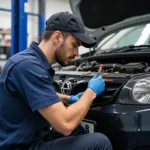Servicing your own diesel car can be a rewarding experience, saving you money and giving you a deeper understanding of your vehicle. While it may seem daunting, with the right preparation and guidance, it’s a manageable task for the DIY enthusiast. This guide will walk you through the essential steps involved in servicing your diesel car.
Preparation is Key
Before you begin, gather all the necessary tools, parts, and information:
- Owner’s Manual: Your car’s manual is your bible, providing specific details about service intervals, recommended fluids, and torque specifications.
- Tools: A basic set of sockets, wrenches, screwdrivers, and pliers are essential. Invest in a torque wrench to tighten bolts to the correct specifications.
- Parts: Oil filter, fuel filter, air filter, cabin air filter (if applicable), and the correct grade and amount of engine oil are the typical items needed for a basic service.
- Safety Gear: Safety glasses, gloves, and work clothes are crucial to protect yourself.
Step-by-Step Diesel Car Servicing
-
Safety First: Engage the parking brake, chock the wheels, and disconnect the negative battery terminal.
-
Oil Change:
- Warm up the engine slightly to help the oil flow better.
- Position the drain pan under the oil drain plug (refer to your owner’s manual for its location).
- Unscrew the drain plug and let the oil drain completely.
- Replace the drain plug with a new crush washer if required.
- Locate and remove the oil filter. Pre-fill the new oil filter with fresh oil before installing it.
- Add the recommended amount and grade of engine oil to the engine.
-
Filter Replacements:
- Air Filter: Usually located in a black box near the engine, simply unclip the housing and replace the old filter with the new one.
- Fuel Filter: The location varies, but it’s often near the fuel tank or engine bay. Depressurize the fuel system (consult your owner’s manual), then carefully disconnect the fuel lines and replace the filter.
- Cabin Air Filter: Typically found behind the glove box or under the dashboard, this filter cleans the air entering the cabin. Remove the cover and replace the filter.
-
Fluid Checks:
- Coolant: Check the coolant level and top it up if needed using the correct coolant type.
- Brake Fluid: The brake fluid reservoir is usually located near the firewall on the driver’s side. Top up if necessary with the correct DOT grade fluid.
- Power Steering Fluid: Check the power steering fluid level and top up using the specified fluid.
-
Visual Inspection:
- Belts: Check for any cracks, fraying, or glazing on the belts. Replace if necessary.
- Hoses: Examine all hoses for leaks, bulges, or cracks. Replace any damaged hoses.
- Lights: Ensure all lights are functioning correctly.
- Tires: Inspect tire pressure and tread depth. Rotate tires according to your owner’s manual recommendations.
-
Reconnect Battery and Test Drive:
- Reconnect the negative battery terminal.
- Start the engine and check for any warning lights.
- Take a short test drive to ensure everything is functioning properly.
Diesel Car Service FAQs
Q: How often should I service my diesel car?
A: Refer to your owner’s manual for specific service intervals. Generally, diesel cars require servicing every 6,000-10,000 miles or once a year, whichever comes first.
Q: Can I use regular motor oil in my diesel car?
A: No, diesel engines require specific oil formulations that meet their lubrication and soot control needs. Using the wrong oil can damage your engine.
Q: What are some signs that my diesel car needs servicing?
A: Common signs include unusual noises, warning lights on the dashboard, reduced fuel efficiency, difficulty starting, and excessive smoke from the exhaust.
Need Assistance with Your Diesel Car Service?
Servicing your own car can be a great way to save money and gain hands-on experience. However, if you encounter any difficulties or are unsure about any step, it’s always best to consult a qualified mechanic. For expert guidance and assistance, feel free to reach out to us via WhatsApp: +1(641)206-8880 or Email: [email protected]. Our dedicated team is available 24/7 to provide you with the support you need.
